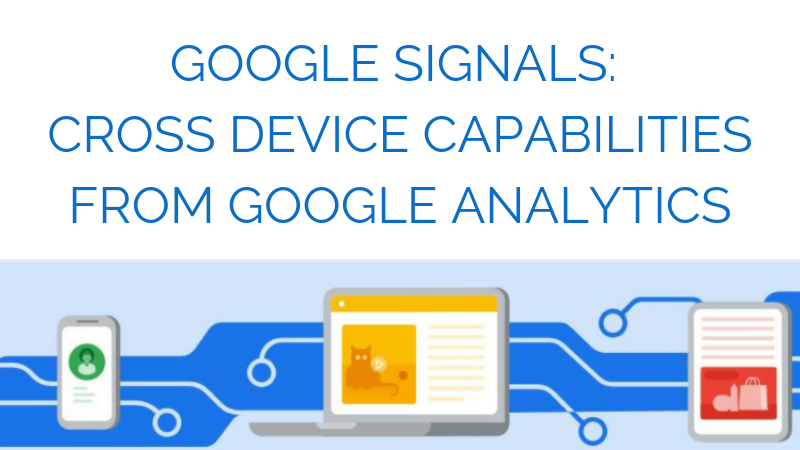What is Google Signals?
Google Signals, first announced in July 2018 in a Google Analytics blog post, collects cross-device data from users who have signed into a Google account on said device and have ad personalization turned on. This includes users signed into gmail, google+, youtube, google play, etc.
Cross-device data does not populate retroactively once Google Signals is enabled, so that is a great reason to get started today!
What can I do with Google Signals?
The biggest feature is the ability to remarket to more users across devices. By using cross-device data to create audiences, you can leverage those audiences in Google Ads or other Advertising platforms. Remarketing audiences will organically improve due to the additional device touchpoints, optimizing your ad spend.
In addition to improved remarketing audiences, Google Signals provides a better understanding of user behavior and the full customer journey. This richer understanding of users improves goal attribution accuracy and the lifetime value of customers.

How Do I Enable Google Signals?
Enabling Google Signals is done in just two easy steps:
- Go to the ‘Admin’ section in Google Analytics and click on “Data Collection” under “Tracking Info”
- Click the blue ‘Get Started’ button and follow the prompts.

What New Reports are Available?
Device Overlap - this report shows website users who interacted with you website via multiple devices. You can also see revenue data by device if you have enabled Enhanced Ecommerce. If Ecommerce is not enabled, the default view will be goal completions. If you do not see overlap, than there have been no users who have visited on multiple devices since the time you activated Google Signals.

Device Paths - this report shows the order in which users interacted with your website on different devices.

Channel - this report uses the A>B>C model of Acquisition, Behavior, and Conversions to show the performance of cross-device channels.

Acquisition Device - last but not least, the acquisition device report allows you to determine if a user converted on the originating device or on another device. The ‘originating device’ is the first device used to interact with your website. If the user completed a goal or purchase with a different device this is reported as ‘Other devices’. Like nearly all of these new reports, acquisition device can help you determine the originating touchpoint to help optimize ad spend on different device types.

Use Cases
Below are some examples of how you can utilize Google Signals to optimize the user experience, effectively target your best users, and optimize ad spend.
For Publishers
- Accurately report on the number of users rather than devices by reporting on cross-device users counts (including 1-day, 7-day, and 30-day activities.)
- Better focus resources and efforts on the most valuable and promising set of users by reporting on different groups of users based on the different device combinations they use.
- Optimize the user experience for the entire customer journey across devices by analyzing user-based reports like active users, funnels, and pathing.
For Marketers
- Optimize ad spend based on cross-device usage by reporting on cross-device marketing performance such as channels, campaigns, etc.
- Offer highly relevant ads based on cross-device usage by remarketing to users across devices.
What are the Privacy Implications of using Google Signals?
With the implementation of GDPR this year, user privacy and maintaining GDPR compliance are of utmost importance to publishers and marketers. As with any data gathering and reporting tool you want to make sure you understand the privacy implications of using Google Signals.
First, only users who are signed into a google account and have ad personalization enabled are aggregated and anonymized in all data gathered for cross device reports. In addition, as with all Google Analytics related tools, do not collect Personally Identifiable Information (PII) in an event or custom dimension. Finally, to ensure GDPR compliance, you should receive prior affirmative consent from users before using ‘User ID’ and tracking activities of users.
What are the Limitations with Google Signals?
There are some limitations to the data collected by Google Signals, such as data cannot be:
- Exported to BigQuery
- Used in Google Analytics dashboards
- Used in Custom Reports or Tables
- Accessed in User ID views
- Segmented via Google Analytics segments
- Accessed via Google Analytics reporting API
- Accessed in Mobile App Properties
- Accessed in Data Studio
Overall, Google Signals is a game changer. Not only does it provide additional reports and new ways to analyze the customer’s cross-device journey on your website, but it also helps improve your remarketing audiences by adding to the pool of devices advertisers can use to retarget potential customers.
Are you ready to take your data and analytics to the next level? Contact your InfoTrust Consultant today to discuss how we can provide solutions to your specific needs.










